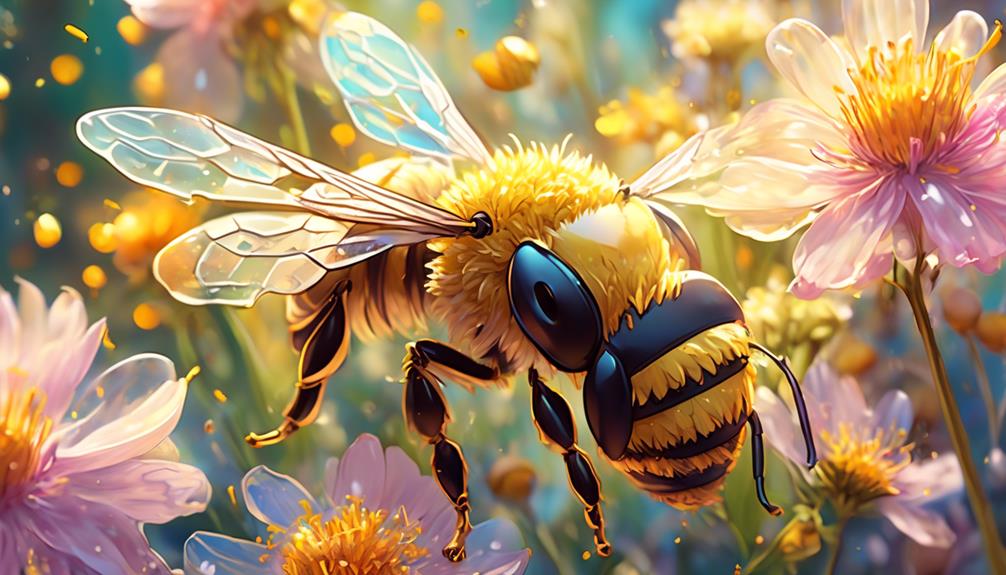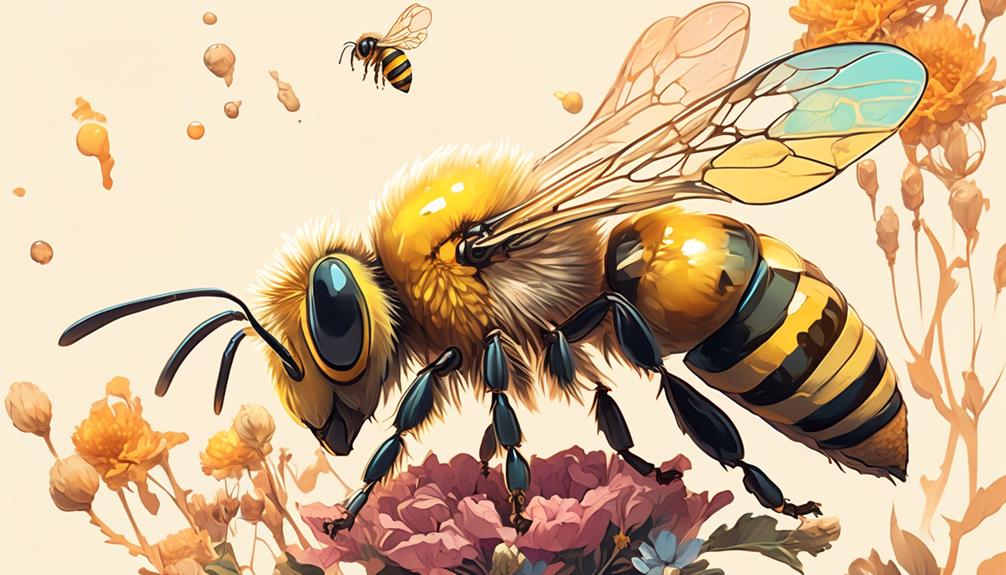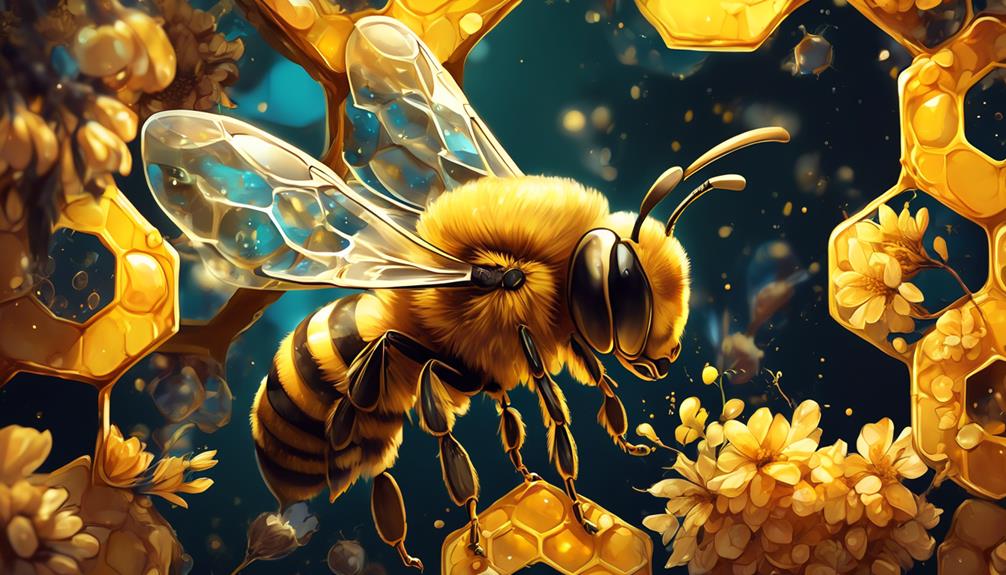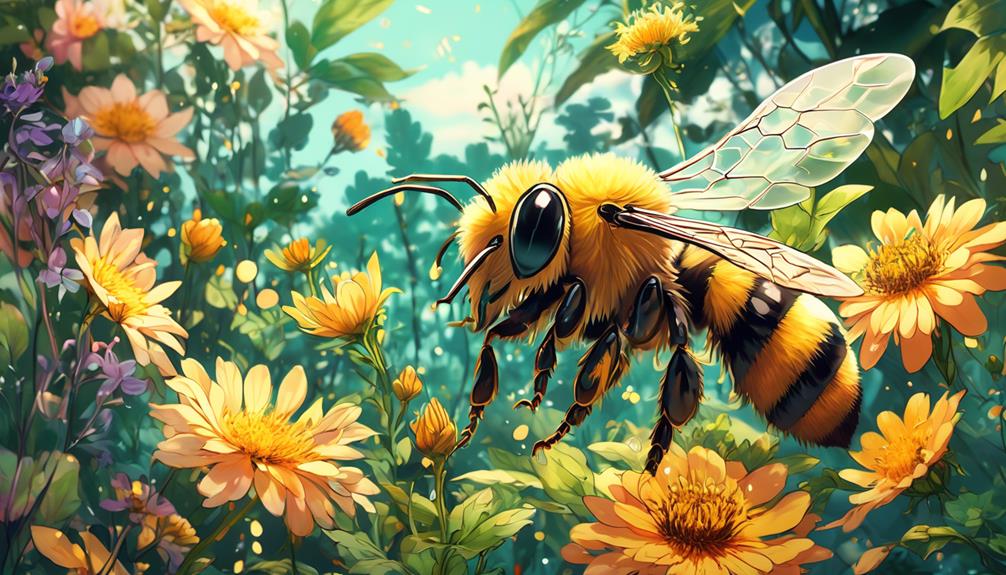Peek into the intriguing world of bee biology and uncover whether these vital pollinators have the ability to regrow their wings.

Can Bees Regrow Wings?
You see them buzzing in the garden, you hear their gentle hum on a warm summer day, and you might even fear their stings – bees, those industrious insects that play a critical role in our ecosystems.
But have you ever wondered about the resilience of these tiny creatures, especially when it comes to their delicate wings? Imagine if a bee, through some unfortunate incident, damages its wings. Can it repair them? Can it regrow them?
These questions might seem insignificant initially, but they stem into a broader, more intriguing discussion about the regenerative abilities of insects, the intricacies of bee biology, and the impact any damage might have on pollination and, by extension, our entire ecosystem.
Stick around, you're about to get a fascinating insight into the world of bees.
Key Takeaways
- Bees have a three-part body and two pairs of wings that lock together during flight.
- Bee wings develop during the pupa stage and their health is crucial for their overall development.
- Bees lack the ability to regrow or repair damaged wings, unlike their regenerative abilities for their digestive tract lining.
- Damaged wings can limit a bee's mobility and ability to pollinate plants, which can have a negative impact on plant diversity, human nutrition, and agricultural economies.
Understanding Bee Anatomy

Before delving into the specifics of bee wing regeneration, it's crucial to gain a comprehensive understanding of bee anatomy. You'll find that bees, like all insects, have a three-part body: the head, thorax, and abdomen. The head houses the brain, eyes, and antennae, while the thorax supports the wings and legs.
Your focus should be on the wings, which are attached to the thorax. They're vital for flight, communication, and temperature regulation. Bees have two pairs of wings – the forewings and the hindwings. When in flight, the larger forewings and smaller hindwings lock together to act as a single surface. This mechanism allows bees to be such precise fliers.
However, their wings are delicate. They're made of thin, transparent cuticle, a material that, once damaged, doesn't naturally repair. Over time, wear and tear from foraging can lead to significant wing damage, impairing a bee's ability to fly.
This fundamental understanding of bee anatomy is essential when considering the potential for bee wing regeneration.
Bee Life Cycle Overview

Understanding the fragility of bee wings and their role in a bee's functionality, it's essential to consider these aspects within the broader context of the bee's lifecycle.
The bee life cycle consists of four main stages: egg, larva, pupa, and adult. As you delve into this journey, you'll find that each phase is highly specialized and critical for the bee's survival.
The queen bee begins the cycle by laying an egg. If fertilized, it will become a worker bee, unfertilized eggs develop into drones. During the larva stage, bees are helpless, relying on worker bees for nourishment.
The next stage, pupa, is a time of transformation where wings, among other features, develop. It's here that the vulnerability of their wings becomes most evident. Wing health is crucial during this phase as the slightest damage can severely impact the bee's ability to function as an adult.
Lastly, the bee emerges as an adult, ready to contribute to the hive. Worker bees, which are predominantly female, can live for several weeks. Drones, or males, live slightly longer, while the queen can survive for several years.
The bee lifecycle is a complex, delicate process where each stage is integral to the insect's survival, especially the health and development of their wings.
Damages to Bee Wings

When a bee's wings sustain damage, it significantly hampers their ability to perform essential tasks, such as foraging for food or defending the hive. This damage can occur due to various factors. Predators, adverse weather conditions, and physical obstacles may cause abrasions, tears, or complete severance of wings.
You'd also find that disease and parasites can be detrimental. For instance, the parasitic Varroa mite can weaken a bee's wings, impeding flight. Domestic bees often face the risk of wing deformities due to the Deformed Wing Virus, spread by these mites.
Older bees may also suffer from wing degeneration. Over time, the constant flapping erodes the wing's edges, reducing flight efficiency. The wing's translucent cuticle can fray, leading to a worn, ragged appearance.
It's important to note that damage isn't always immediately fatal. Bees can still survive with minor wing damage but their functionality and lifespan are significantly reduced. In contrast, severe wing damage often results in the bee's death, as it can't eat, mate or escape predators.
Understanding these damages can aid in bee conservation strategies, as we strive to maintain healthy bee populations.
Bee's Regenerative Abilities

Contrary to what you might hope, bees unfortunately lack the ability to regrow or repair their damaged wings. This limitation is due to the fact that, unlike some species such as starfish or lizards, bees don't possess pluripotent stem cells. These cells have the potential to turn into any cell type, allowing for the regeneration of body parts.
In bees, once a wing is damaged, it's permanent. The wear and tear of bee wings is a natural part of their life cycle, and older bees often show signs of wing damage. Bees don't have a healing mechanism for their wings, nor do they've the capacity to replace lost wings entirely.
However, bees do have some regenerative abilities. They can regenerate their digestive tract lining which is crucial for their survival. This process involves a group of cells known as enterocytes, which continuously renew themselves to maintain the health of the digestive tract.
But when it comes to their wings, bees aren't so fortunate. Despite their remarkable resilience and adaptability, the ability to repair or regrow wings is simply not part of a bee's biological makeup.
Impact on Pollination and Ecosystem

It's crucial to realize that a bee's inability to regrow wings has significant implications for pollination and, as a result, our broader ecosystem. Damaged wings limit a bee's mobility and therefore its ability to pollinate plants. Bees, as you know, are vital pollinators in our ecosystem, facilitating the reproduction of a vast majority of plant species. Reduced pollination can result in decreased plant diversity, negatively affecting the food chains that depend on these plants.
Furthermore, impaired pollination may lead to a decline in the production of fruits, vegetables, and nuts, impacting human nutrition and agricultural economies. Pollination is also essential for maintaining habitats for wildlife, so a disruption can have cascading effects on biodiversity.
Lastly, the inability of bees to regrow wings can potentially affect their survival rate, leading to a decline in bee populations. This is a grave concern, as bees are keystone species; their actions significantly influence the whole ecosystem. If the bee population were to significantly decrease, it would trigger a domino effect, destabilizing our entire ecosystem.
Therefore, it's clear that wing regeneration in bees is an important area for scientific research.
Frequently Asked Questions
How Do Bees Communicate With Each Other and Their Colony?
Bees communicate with each other and their colony through a complex dance language. You'd observe a worker bee performing a 'waggle dance' to share the location of a food source. It'll shake its body in a specific pattern to indicate direction and distance.
Additionally, they use pheromones for social communication. For instance, an alarm pheromone is released to alert others of danger.
How Does Weather Influence a Bee's Flight?
Weather significantly impacts a bee's flight. Cold temperatures can immobilize bees, making flight impossible. Rain, wind, and humidity also affect their ability to fly. You'll notice bees aren't active during stormy or cold weather.
They're sensitive to changes in atmospheric pressure, which alert them to incoming bad weather. So, bees usually stay in their hives during such conditions, focusing on indoor tasks like tending to the queen and larvae.
What Are Some Natural Predators of Bees?
You're curious about natural predators of bees. Various birds, spiders, and insects like dragonflies prey on bees.
Mammals such as skunks and bears are also known bee predators, primarily for their honey.
Even some species of bees, like the infamous 'killer bee', can attack and take over other bee colonies.
It's a tough world out there for bees, facing risks from predators as well as environmental changes.
Are There Any Notable Differences Between the Wings of Various Bee Species?
Yes, there are notable differences in the wings of various bee species. You'd find that the size, shape, and vein patterns differ significantly between species.
For instance, the wings of a honey bee are smaller and more rounded compared to the elongated wings of a carpenter bee. These variations in wing structure contribute to each bee species' unique flight capabilities, speed, and maneuverability.
It's a fascinating area to delve into if you're interested in entomology.
How Does the Process of Honey Production Take Place Within a Bee Hive?
Honey production starts when bees collect nectar from flowers. Back at the hive, they'll pass it to other bees through regurgitation. These bees chew the nectar, breaking down its complex sugars.
Then, they'll deposit the nectar into a honeycomb cell and fan it with their wings to evaporate excess water. Once it's the right consistency, they'll seal the cell with beeswax.
This process creates the delicious honey you enjoy.
Conclusion
In conclusion, you've learned that bees, despite their impressive anatomy and life cycle, can't regrow wings once damaged. This lack of regenerative abilities significantly impacts their role in pollination and the ecosystem.
It's essential to protect bees from harm, as even minor wing damage can lead to dire consequences for these vital pollinators and, by extension, our environment. Understanding and respecting bee biology promotes a healthier, more sustainable world.



